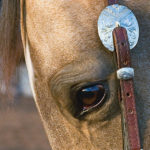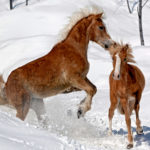One of the most unique and valuable equestrian experiences I ever had happened many years ago at summer camp. While riding in a group lesson in the outdoor ring, one of the other students simply fell off the side of her horse like a rag doll. As she lay there unconscious, one of our instructors ran to get help. The assistant trainer stayed, standing over her to make sure she remained immobile in case of a back injury. Then things got weirder: The instructor suddenly refocused her attention on the water tap in the corner of the ring. She quickly ran to the hose and proceeded to blast the motionless girl in the face and chest with water. By then, other camp counselors had arrived and were trying to wrench the hose from the seemingly crazed assistant trainer. In response, she pulled it out of reach and continued spraying, screaming, “I am saving her life! She has heatstroke!”
When the ambulance arrived 30 minutes later, the paramedics agreed: The instructor’s calm, quick and thoughtful reaction probably saved the girl’s life. If she hadn’t been there, we would have likely hovered over the fallen rider for the time it took the ambulance to get up the mountainous dirt road while she continued to bake in the hot sand arena under the blazing midday sun.
Since then I have become very aware of how the heat affects riders. Now, as an instructor myself, I make every attempt to be educated so that I can prevent and treat overheated students. While we all know about putting on sunscreen to protect us from sunburn and drinking lots of water to stay hydrated, there are many more things to consider when preparing for the hottest summer months (which also happen to be right in the middle of show season). Here are some tips that I have picked up as a trainer and from talking to professionals who deal with the effects of extreme heat on a regular basis.
Before Going Out in Extreme Temperatures
Your body requires time to acclimate to extreme heat. With so many dressage riders working a typical day job and/or riding indoors at home, it can be harder for some to adjust to the midday sun and heat of outdoor riding in one day. This makes midday activities like long weekend trail rides and afternoon ride times at a show high-risk for problems related to heat and the sun.
“I know some farmers that are 100 years old, and they have farmed in the summer in jeans,” says emergency medical technician (EMT) and farmer Mike Smallwood. “A big part of it is being acclimated. If you are in air conditioning all day, going to an outdoor show on the weekend, the heat is going to affect you much more than someone who is outside a lot. People who are outside all the time are probably more likely to drink water all day because they are used to what you have to do to stay hydrated and cool. For someone who is outside all day, 80 degrees may feel cooler to them if they have been outside in 95-degree temperatures.” Smallwood has been a fixture at many dressage shows and has seen a lot of problems related to heat.
It is also important to watch what you eat and drink before riding in extreme heat. Midday rides on the weekends, in particular, present another change of schedule as people often go out to dinner and cocktails more frequently on the weekends. Even having one glass of wine at dinner can put you on the road to dehydration, and riding at high noon the next day only makes it worse. Avoid anything that acts as a diuretic. Increase your water intake during the summer, especially on the weekends.
Another lesser-known fact is that your helmet needs to be protected from extreme heat if you want to guarantee it will work as advertised. “It is probably worth saying that Styrofoam/polystyrene starts to melt at 170 degrees and is molded with steam at 212 degrees Fahrenheit. Drying a helmet on a heater will do damage as well as leaving the helmet in full sun inside a car,” according to an official statement from helmet-maker Charles Owen.
Prevention in the Sun
Preparation is key when the temperature rises. “Anything in the 80s and above, especially with high humidity, is probably a time to really start paying attention,” says Smallwood. “With the humidity higher, you sweat more and you lose water and salt.”
Between 10 a.m. and 3 p.m., try to stay out of the sun when its damaging “UVA/UVB rays are the strongest,” says clinical esthetician and dressage rider Denise Matthews. “It is important to apply your sunscreen at least 20 minutes before you go out in the sun so that it can bond to your skin. The minimum sun protection factor (SPF) you should use is 30, but I prefer 45. There are different types of sunblocks, and my favorite is any physical block with michronized zinc or titanium in it because, although there are also chemical blocks, some people can have sensitivity to those. If your skin is sensitive, watch out for sunblocks with alcohol—especially some aerosol sprays with propellant, which can be drying or irritating. Regardless of what you choose, you have to reapply every two hours to minimize exposure. If you are dirty, make sure you use baby wipes before reapplying.”
Try to reduce exposure time. If you don’t have to be out in the heat, get out of it. Do the task at a slower pace, so you don’t work up a sweat and overexert yourself. “On the farm, if you have 10 stalls to do, do a couple then go inside and get some water and relax,” says Smallwood. “Go out, do another two then go back inside.” The same is true for horse shows. Do what you can the night before, during the cooler temperatures.
To help prevent dehydration and heatstroke, especially in extreme heat and at horse shows, keep a bucket of ice, water and cheap hand towels (buy in bulk) with you. Drink a full bottle of water after every ride and don’t be afraid to put a cool towel around your neck during walk breaks and as needed. Drinking the right fluids and staying cool the day of the event are key. “The biggest thing is hydration: water or other fluids like Gatorade. I know it is hard to do at a horse show, but stay out of the sun and stay in air conditioning as much as possible,” says Smallwood. “Also, in my personal experience, you should only eat light foods. If you go out and eat a cheeseburger, it is a heavier food and it won’t sit well. If you end up overheating, it will end up coming back to visit you later.”
What you put on your skin before going out in the sun can also matter. “Well-moisturized skin is healthier, so you have an easier time dealing with sun exposure,” says Matthews. “Drier skin is more likely to burn.” Be careful of what other things you are putting on your skin, she adds. “While over-the-counter alpha hydroxy is usually fine, people with sensitive skin or using doctor-prescribed, stronger formulas can be at risk for sun sensitivity. Try to use it at night and if you do get irritated, cut down to fewer times a week if you are going to be out in the sun. Similarly, retinoids/ retinols like Retin-A, salicylic acids and other acne medications can make you sensitive to the sun. Since a lot of riders are teenagers often using these medications, it can be a problem.”
Regardless of how sensitive you are to the sun, everyone should leave a bottle of sunscreen at the back door to apply before stepping outside every day. It also helps to wear a hat and clothing with a tight weave. Some clothing is also now providing SPF protection. Even long-sleeved shirts with a loose weave might not necessarily protect you from the sun much more than a tank top.
Signs of a Problem
It is important to know what you are looking for when you or someone else is starting to suffer from heat-related problems. Also recognize that everyone is susceptible. “I was working outside and through my own stupidity got myself to heat exhaustion,” says Smallwood. “You get it quicker than you think and if you push yourself too hard, the recovery time takes forever.”
Smallwood says a red flag is when someone starts to sweat profusely. “They might look flushed in the face and have heavy breathing, almost panting. Those are the key things to look for. As it becomes worse, the person will experience cramps, dizziness, nausea. You get to heatstroke stages when people stop sweating. That is a real bad sign.” In all cases, treatment is necessary and you should call for medical help.
Do the following if medical help is not immediately available:
1. Direct someone to go for help.
2. Get the person out of the heat or find a way to block the sun.
3. If he has fallen, don’t move him, in case of traumatic injury. Always treat this type of situation as if it is the worst-case scenario.
4. Cooling areas where the main blood vessels run helps cool the body quickly. If you can get ice packs, it is beneficial to place them in the armpits, groin and around the neck.
5. Do not use ice directly. Large quantities of ice poured directly on a victim can cause frostbite, even if someone is overheating. Wrap the ice in a wet towel soaked in cool water.
If you are not suffering from a severe case, but get sunburned, anything with green tea or aloe will help minimize redness and inflammation. “If you are really burned, you might want to check with your doctor about getting a steroid to remove inflammation,” says Matthews. Remember, it takes longer to recover once you are dehydrated and burned than the time it takes to prevent these things from happening in the first place.
The key is acclimating yourself, drinking hydrating fluids, avoiding heavy food, protecting yourself with sunblock and appropriate clothing. Whenever possible, stay out of the sun, especially during the hottest hours. If you do have to go outside, take it slow and watch for signs of heat exhaustion. Know your personal sensitivities and make sure no medications or lotions you use make you more sensitive to the sun. In the end, you will be a safer, more productive athlete. Stay cool!
Denise Matthews has been a clinical esthetician for more than 20 years and works at Foothill Cosmetic Surgery in Glendora, California (foothillcosmeticsurgery.com).
Mike Smallwood is a farmer, EMT and professional firefighter at the Carroll Manor Fire Company in Adamstown, Maryland.
Hilary Moore is Senior Editor at Dressage Today and a dressage instructor and trainer based in Maryland (mooredressage.com).





